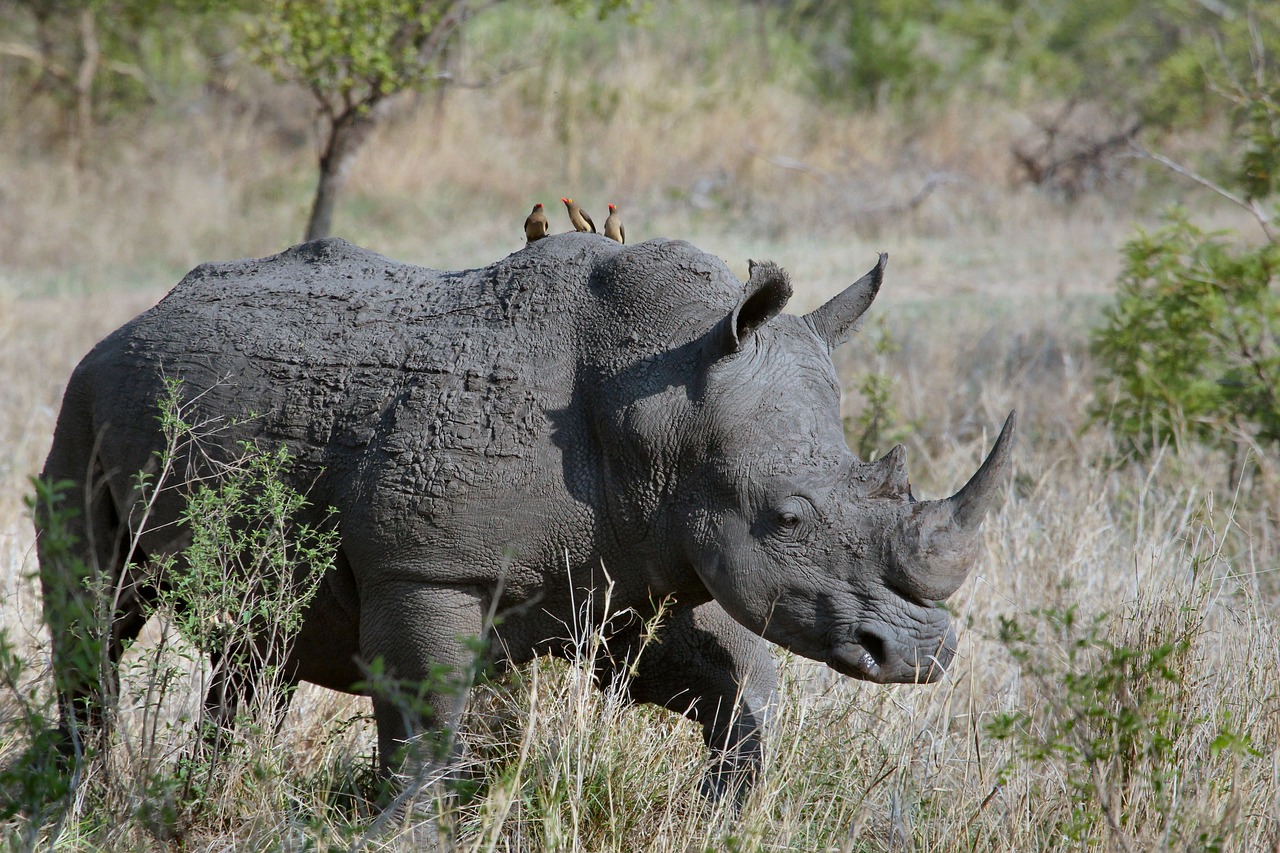- Rhinoceroses are large, herbivorous mammals that belong to the family Rhinocerotidae.
- There are five extant species of rhinoceros: the white rhinoceros, black rhinoceros, Indian rhinoceros, Javan rhinoceros, and Sumatran rhinoceros.
- Rhinoceroses are known for their distinct horns, which are made of keratin and are not true horns but rather tightly packed hair.
- The horns of rhinoceroses are highly sought after and unfortunately, have made them a target for illegal poaching.
- Rhinoceroses have thick, protective skin that can be as much as 2 centimeters thick, providing defense against predators and environmental hazards.
- They are large animals, with adult rhinoceroses weighing anywhere from 1,000 to 6,000 kilograms (2,200 to 13,200 pounds).
- Rhinoceroses are herbivores and primarily feed on grass, leaves, shoots, and fruits.
- These mammals have a unique digestive system that allows them to extract nutrients from tough plant material.
- Rhinoceroses have poor eyesight but possess an excellent sense of smell and hearing, which aids in their survival.
- They are solitary animals, except for the white rhinoceros, which can be found in small family groups called “crashes.”
- Rhinoceroses are generally peaceful animals, but when provoked or threatened, they can be very dangerous due to their size and strength.
- The white rhinoceros is the largest species of rhinoceros, with males weighing up to 2,500 kilograms (5,500 pounds).
- In contrast, the Sumatran rhinoceros is the smallest species, weighing between 500 and 800 kilograms (1,100 to 1,800 pounds).
- Rhinoceroses have a long gestation period, with pregnancies lasting around 15 to 16 months.
- After birth, rhinoceros calves stay close to their mothers for several years, learning essential survival skills.
- The horns of rhinoceroses continue to grow throughout their lives, and they can reach lengths of up to 1 meter (3 feet).
- Rhinoceroses are primarily found in Africa and Asia, with different species occupying different regions.
- The white rhinoceros is native to southern Africa, while the black rhinoceros can be found in eastern and southern Africa.
- The Indian rhinoceros is native to the Indian subcontinent, while the Javan and Sumatran rhinoceroses are found in Southeast Asia.
- Rhinoceros populations have faced a significant decline due to habitat loss, poaching, and illegal wildlife trade.
- Efforts are being made to protect and conserve rhinoceroses through various conservation programs and initiatives.
- Rhinoceroses play an important ecological role as grazers and browsers, helping to shape and maintain their respective habitats.
- They are also considered a flagship species, representing the need to protect and conserve biodiversity.
- Rhinoceroses are strong swimmers and can often be found near water bodies, such as rivers and lakes.
- These mammals have a lifespan of around 35 to 50 years in the wild, although some individuals have been known to live longer.
- The skin of rhinoceroses can be quite sensitive, and they often wallow in mud to protect themselves from insects and regulate their body temperature.
- Rhinoceroses have historically played a role in various cultures and mythologies, symbolizing power, strength, and protection.
- The collective noun for a group of rhinoceroses is a “crash” or a “herd.”
- Rhinoceroses communicate with each other through various vocalizations, body postures, and scent marking.
- The horn of a rhinoceros is not attached to the skull but is formed from a mass of compressed hair.
- Rhino horns have been traditionally used in some cultures for medicinal purposes and as ornamental items, leading to their illegal trade.
- Rhinoceroses have a relatively low reproductive rate, with females giving birth to a single calf every two to five years.
- The Javan rhinoceros is critically endangered, with only a few individuals remaining in the wild.
- The black rhinoceros is also critically endangered, mainly due to poaching for its horn.
- Rhino conservation efforts include habitat protection, anti-poaching initiatives, and community engagement to promote sustainable practices.
- Rhinoceroses have prehensile lips that they use to grasp and pluck vegetation.
- The southern white rhinoceros is the most abundant rhinoceros species, with a population that has seen a successful recovery from near extinction.
- Rhinoceroses have a complex social structure, and individuals recognize and interact with one another using various behaviors.
- The horn of a rhinoceros is not innervated and does not have a direct blood supply, which means that its removal does not cause pain.
- Rhinoceroses can run at speeds of up to 40 miles per hour (64 kilometers per hour) when threatened.
- The front horn of a rhinoceros tends to be longer and more prominent than the rear horn.
- The name “rhinoceros” comes from the Greek words “rhino” (nose) and “ceros” (horn), referring to the animal’s distinctive feature.
- Rhinoceroses have relatively poor maneuverability and agility compared to other large mammals.
- Despite their size, rhinoceroses are herbivores and have a specialized diet suited to their digestive system.
- The horn of a rhinoceros is composed of tightly packed keratin fibers, the same material that makes up human hair and nails.
- Rhinoceroses have been known to engage in “mud-wallowing” behavior, which helps protect their skin from sunburn and parasites.
- The rhinoceros horn is not hollow but consists of solid keratin, making it structurally different from horns of other animals like antelopes or cattle.
- Rhinoceroses have a unique body shape with a pronounced hump over the shoulders, thick legs, and a robust build.
- The Sumatran rhinoceros has the densest coat among rhinoceros species, consisting of bristly hair.
- Rhinoceroses have a strong sense of territory and may mark their territories with dung piles and scent markings.
Facebook Comments


































